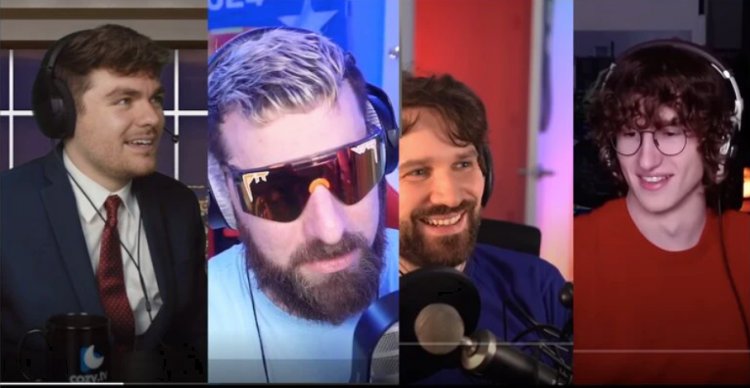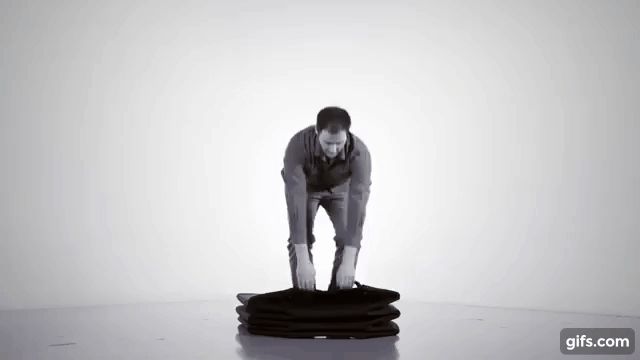Taking Charge: Gen Z Activists Showing The Way On How To Exercise Free Speech
He claimed the protestors believed “in a conspiracy that the election was being stolen and that they could prevent this from happening by storming the Capitol.” Next, he reckoned that Fuentes was “smart enough not to enter the Capitol building, although he had no issues inciting his friends to do so.” Finally, he argued that the January 6th “riot” was driven by a “bogus theory.”


While academia and social-media grapple with “provocative” speech, young activists are creating an economy by embracing discussions in a nation experiencing sociopolitical turmoil.
The brewing sociopolitical tension over the past six years has seemingly exploded like red hot lava into 2022. And we’re only halfway through the year.
We’ve learned about blood-shed in stores, schools—and across social media after the world’s richest person made a deal to purchase Twitter and caused outrage among users.
Meanwhile, the world of internet-savvy millennial and Gen Z political commentators and activists is experiencing a phenomenon.
While academia grapples with discussing polarizing topics, young entrepreneurial minds across the Left and Right are engaged in these conversations, independent of Big Tech censorship.
Launched in October 2021, ‘cozy.tv’ is an online streaming service founded by 23-year-old businessman and activist Nicolas J. Fuentes. Within a year, the site has attracted over six million monthly visits, where viewers can freely watch their favorite streamer’s political, entertainment or gaming show.
Recently welcomed on cozy.tv is “Politically Provoked”, a show that invites the socially sensitive questions many Americans might be starving to ask. In mid-May, four streamers participated in a debate that ultimately explored:
- whether storming the U.S. Capitol on January 6th, 2021 was planned;
- evidence of fraudulent activity in the 2020 election;
- the motivation and mental state of the mass-shooter in Buffalo, NY;
- immigration, assimilation and changing demographics in the United States;
- whether the language of activism triggers thoughts leading to violent behavior.
The first to arrive was 18-year-old Rose Wrist, a “progressive social democrat” with a growing YouTube channel of over 18,000 followers since 2019. Joining the debate was 33-year-old Steven Kenneth Bonnell, who has gained attention since 2011 for livestreaming political discussions while playing video games. With over 400,000 followers on YouTube, Bonnell, who demonstrates a center-left and socially liberal bent, was invited to multiple colleges this year, such as the University of Tennessee.
On the right-wing spectrum entered 34-year-old Anthime Joseph “Tim” Gionet, who described himself as “a January 6th defendant.” He worked for BuzzFeed as a media strategist and now livestreams gaming, occasional debates and Sunday Catholic Rosary. Accompanying Gionet was Fuentes, who hosts a political commentary show, America First, around five days a week. Since 2017, he has gained over 180,000 followers on multiple social media platforms combined.
The debate lasted over 3 hours and evoked no shortage of name-calling. However, between accusations of not participating in “good faith” and “having a third-grade reading comprehension,” constant efforts were made to re-engage, challenge, and understand conflicting perspectives.
Was the storming of the Capitol planned or initiated?
He claimed the protestors believed “in a conspiracy that the election was being stolen and that they could prevent this from happening by storming the Capitol.” Next, he reckoned that Fuentes was “smart enough not to enter the Capitol building, although he had no issues inciting his friends to do so.” Finally, he argued that the January 6th “riot” was driven by a “bogus theory.”
Gionet, who reportedly live-streamed inside Nanci Pelosi’s office, admitted he was “arrested by the Feds” and is fighting a legal battle. Yet, he refuted that the rally was a “riot”, exclaiming that it was a “largely peaceful protest” and stressed that he had “followed the action” into the building to live stream.
Fuentes disputed Wrist and Bonnell’s characterizations, stating that except for a few groups, “people went there to try to stop the actual counting of the electoral votes,” devoid of any plan to storm the building. He added that “the number of conspiracy charges is like 50 to 100 out of 500,000 [demonstrators].” To date, at least 11 individuals have been charged with “seditious conspiracy.”
Wrist challenged Fuentes about statements he’d made through a megaphone outside the Capitol—which could be literally interpreted as inciting a breach of the building—such as “break down the barriers and disregard the police” and “now we are forcibly evicting them [politicians] from the People’s House.”
“I’ll admit, for legal reasons, I probably should have chosen my words more carefully,” Fuentes said but then remarked, “I was not referring to the building. I’m referring to [Capitol] Complex.”
Unsatisfied, Bonnell probed the Gen Z-er about the “perception of words” and added that “your presence at that area was to goad people on. That doesn’t require a conspiracy. That doesn’t require preplanning—like you can do that in the heat of the moment. Right, that’s the argument we’re making.”
The debate accelerated into a frenzy over words, with Fuentes emphasizing that his opponents were unnecessarily quizzing “the semantics” of speech rhetoric. Eventually, the topic was forced to change: the motivation behind the January 6th rally.
Was there fraudulent activity in the 2020 election?
As a counterweight, Gionet highlighted that in the last four years while Donald Trump was in office, the left-wing media and Democrat politicians would consistently claim that “Hillary actually won” and “Russia, Russia, Russia,” referring to allegations that the 2016 election was rigged in favor of the Republican party.
Meanwhile, Fuentes highlighted that an Arizona ballot audit had over “100,000 discrepancies” and a lack of paper trail for 74,000 mail-in ballots supposedly sent to voters. Bonnell objected with a response from Maricopa County in Arizona, in which the mail-in ballots were “for people just going to an early voting center.”
The following exchange reflected a fundamental difference between the debaters’ trust in government systems. Fuentes declared that election officials in Maricopa County were “making assumptions about these discrepancies, which is the problem” and added, “they investigated themselves and found there was no fraud. That’s cute. That’s convenient.”
Unsurprisingly, the argument ended with all debaters holding firmly to their initial beliefs.
Motivation behind mass shooting doesn’t rule out changing American demographics
Furthermore, he preempted his argument using statistics, claiming that “in 14 out of the 21 years between 1994 and 2019, in which fatal terror attacks occurred, the majority of deaths resulted from right-wing attacks.”
The 18-year-old accused Fuentes of propagating the belief that contributes “to the forces that radicalize young White men into committing mass shootings.” He referenced the America First host’s past remark: “If you are a White male Zoomer, remember that the people in power hate you and your unborn children, and they will try to genocide you in your lifetime.”
Gionet leapt to Fuentes’ defense, stating that irrespective of the tragic incident, “you know White people are about to be a minority in a country that they founded.” He referenced the United Nations (UN) website on “replacement migration” and added, “I mean, even a lot of people on the Left acknowledge this now.”
Fuentes tried to clarify his political message. “My show, for the most part, is Christian. And I’ve converted people to Catholicism. We do not support killing, not morally and even as a strategy. It just doesn’t even make sense.”
Referring to the declining proportion of White Americans, the debater added, “I don’t think that people that oppose this should be vilified and blamed for anti-social violence by mentally ill people.”
By “mentally ill,” Fuentes was referring to the killer being admitted for a mental health evaluation and arriving at school covered in a hazmat suit.
Does the language of activism trigger people to commit violence?
To this end, Bonnell added that the man who discriminately killed 10 Black people was “convinced by rhetoric.”
“The shooter was mentally ill. He’s not convinced by anything,” Fuentes defended.
From here, the debate spiralled around defining mental illness, whether the legal system would accept the killer as “clinically insane and unfit to stand in court” and if rioters in Black Lives Matter (BLM) and Antifa protests would be labeled as such, given their erratic behavior and tendencies toward looting.
Since the tragic incident in Buffalo, we’ve also learned about a retired federal agent regularly communicating with the mass-shooter and joining a private online chat where the killer shared details of the planned attack.
Promoting “White identity” by spreading a Christian message as a deterrent to violence
On this note, Fuentes reasoned that one could only commit “discriminate racial killings” if they are “racialist.” He then defended his activism that noticeably promotes “White identity” in primarily Gen Z and younger men:
“I mean, there are people that worship race. There are people that think that race is the end. We [at America First] don’t think that: in some sense, we’re Universalists because we’re Christian. I think that anybody can become a Christian. I think anybody could become saved.”
Immigration and assimilation into American society
“Let’s say we have on our borders right now two caravans. On one end, we’ve got a million secular Danish people. And then, on the other end, we’ve got a million pretty Catholic Nigerians. Who would you want coming to the United States of America?”
“Well, ultimately, I’d probably prefer the Danish.”
“But if you’re a Christian nation and you prefer Christians and anybody can be Christian, why the Danish over the Nigerians?”
“Because they are culturally assimilable in the way that the Nigerians aren’t,” Fuentes clarified before adding that the Catholics in the hypothetical scenario are “not of the same race,” in reference to being non-White.
Bonnell argued that Fuentes was indeed “talking about some form of racial essentialism.” The America First activist didn’t deny that “race is an essential characteristic of people.” However, Fuentes distinguished himself from those he believes are non-Christian and advocate for ethnic cleansing as a legitimate political solution to a believed “problem of diversity.”
The probing didn’t stop.
“But then Christianity is not as universal as you made it sound?” Bonnell said.
Wrist, meanwhile, directed a question at Fuentes. “What’s more important: political, ideological identity or racial identity?”
“For the sake of immigration, probably race.”
“So do you think culture is inherently derived from race?” asked the 18-year-old progressive.
“Absolutely. Absolutely.”
Interestingly, their dialogue never explored the transfer and absorption of ideas that have been imperative to American individualism and excellence when previous generations of vetted immigrants consciously made America their new home, irrespective of their country of origin.
Nor did the debaters confront declining levels of patriotism among young Americans and the slump in U.S. history and civic education, which endangers preserving a national character in a republic under 300 years old.
Frankly, suppose academic institutions continue to push an anti-American contingent, coupled with radical postmodern left-wing thought and the ethos of Marxism. As such, it is a direct threat to that pioneering can-do spirit and the idea of local self-government rooted in the foundation of this great nation.
In any case, the debate revolved around defining terminology in the context of mass immigration against accusations of being “sloppy” or “in bad faith.” The left-wing debaters claimed their opponents’ use of “White genocide” did not fit the UN international definition.
Bonnell pressed harder against Fuentes and asked if he would “ship people back to countries of origin” given they were non-White.
“No,” the activist replied, adding that he would probably take control of immigration, irrespective of their race. “You could bring in a 100,000 of anybody [a year] and it wouldn’t matter who they are.”
Dispute about current trend of changing demographics
“Even if we completely stop all immigration, eventually, what is going to happen is you will see the non-White population make up larger portions of the total percentage of the population…So, what’s your solution for that?”
“Well, here’s the thing,” Fuentes expressed. “If we stopped immigration, largely the demographic transition would halt.”
“But it wouldn’t stop, correct?”
“Yes, it would,” Fuentes argued, adding that interracial relationships in the United States leading to a non-White offspring contributes a small percentage of the nation.
“But aren’t they rapidly growing?”
According to a recent Census report, 47 percent of Americans under 18 years are non-White, including “two or more races” or “some other race.” And the number of non-Hispanic White people has decreased as deaths have surpassed births.
“All fertility rates are slowing down,” contested Fuentes as backed by recent findings amongst different groups across the United States.
Considering the trajectory of changing demographics, Wrist asked if his right-wing opponent would be “okay” with America being majority non-White after “x-amount of time.”
“I don’t think that’s going to happen. I don’t want that to happen.”
Fuentes emphasized that “banning immigration” wouldn’t halt America’s non-White population growth but would eventually slow the rate to a “negligible” point.
After a brief pause, Wrist appeared to agree with Fuentes’ estimates. “I would think that probably makes sense,” but then quickly challenged Gionet on an earlier point he’d raised.
“I’ve out-techniqued you. I’ve decided to read,” grinned Wrist, referring to the UN website. “It says, ‘Replacement migration refers to the international migration that a country would need to offset population decline and population ageing resulting from low fertility and mortality rates.’ So it doesn’t have a racial component to it.”
“I have a New York Times piece here by Michelle Goldberg,” Gionet snapped, referring to a 2018 opinion piece that throws punches at a Georgia Republican candidate as “aggrieved Whiteness” and refers to an “embittered White conservative minority” attempting to cling to power.
“The title is,” Gionet continued, “‘We Can Replace Them.’”
Attempting to find common ground despite heated disagreements
Bonnell agreed to an “anti-White agenda” in relation to the language propagated in the media. However, while the gamer condemned his political side when they “engage in reckless rhetoric” that can foster hostilities towards other groups of people, he reckoned that his two opponents were unwilling to do the same.
Fuentes and Gionet adamantly refuted Bonnell’s criticism that their humor and jokes might lead a “mentally disturbed person” to commit violence.
The America First host challenged his opponent:
“On my show, I make jokes, and you know it’s an entertainment show. So yeah, it is there. There are a lot of jokes, but there also is a lot of serious political commentary. As far as political commentary goes, I believe I have a high degree of confidence that it’s pretty easy to discern what’s serious and what’s a joke. And as far as stuff goes, I never advocate for violence.”
Bonnell argued that if he made “enough jokes over a long enough period of time,” then some of his audience might start believing those jokes. He then reasoned in regard to the surge in BLM and Antifa riots:
“I think that it wouldn’t be inconceivable to find out that people in my audience would be part of some of those riots—not the protests—but the riots themselves. So when I see people acting that way, I’m like, maybe it’s not enough to just have a disclaimer at the beginning of my 4-hour rant about how evil cops and conservatives are. Maybe, I actually need to be more aware of my rhetoric, so that when those rioters are rounded up and arrested, and people go through their YouTube history, they’re not going to find my videos. So the people watching me won’t even have those ideas in their heads.”
Fuentes replied, “You know what, that’s honestly fair,” before adding, “not about the shooting so much.”
Ending the debate on a friendly note
While at least three debaters work, live and breathe political discourse, the debate has since received over 125,000 views on cozy.tv, YouTube and Odessey combined.
The very fact that this exchange happened demonstrates the willingness among young Americans—albeit a subset—to come together, despite opposing political beliefs and exercise their First Amendment, however uncomfortable.
Perhaps the rest of America, particularly academic institutions, can take a lesson. These conversations are already taking place—because they have to, in America.
By Cameron Keegan
Cameron Keegan is an independent researcher and writer on American politics, faith, and culture affecting young people through a conservative disposition. Having worked with children, teenagers, and young adults to support their learning and development, Cameron cares deeply about the trajectory of the United States. To learn more about Cameron’s work, visit https://ckeeganan.substack.com, and for comments or questions, send an email to ckeeganan@substack.com.
Enjoy HUGE savings at My Pillow with promo code BSC
The views and opinions expressed in this article are solely those of the author and do not necessarily represent those of The Blue State Conservative. The BSC is not responsible for, and does not verify the accuracy of, any information presented.
Notice: This article may contain commentary that reflects the author’s opinion.
Featured photo courtesey of Cameron Keegan via https://ckeeganan.substack.com/p/exercising-free-speech-despite-big?s=w.




















